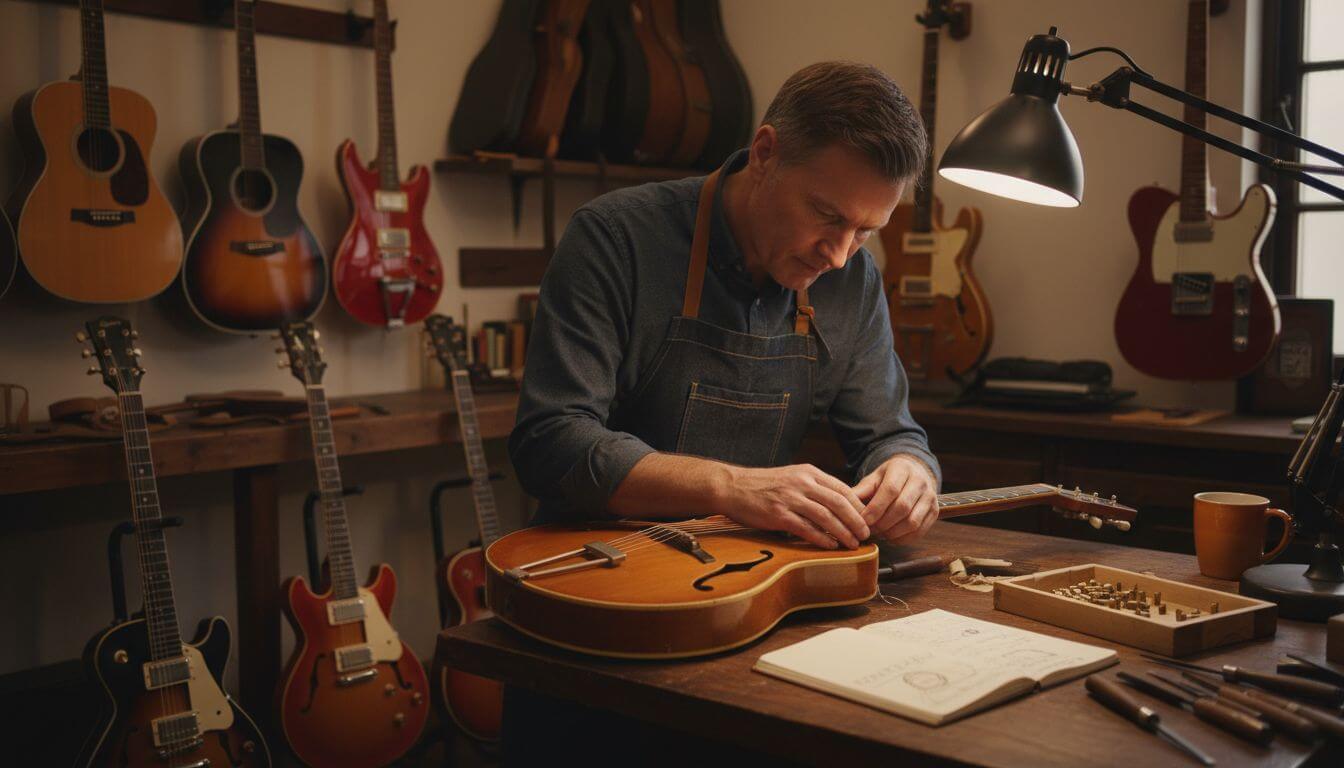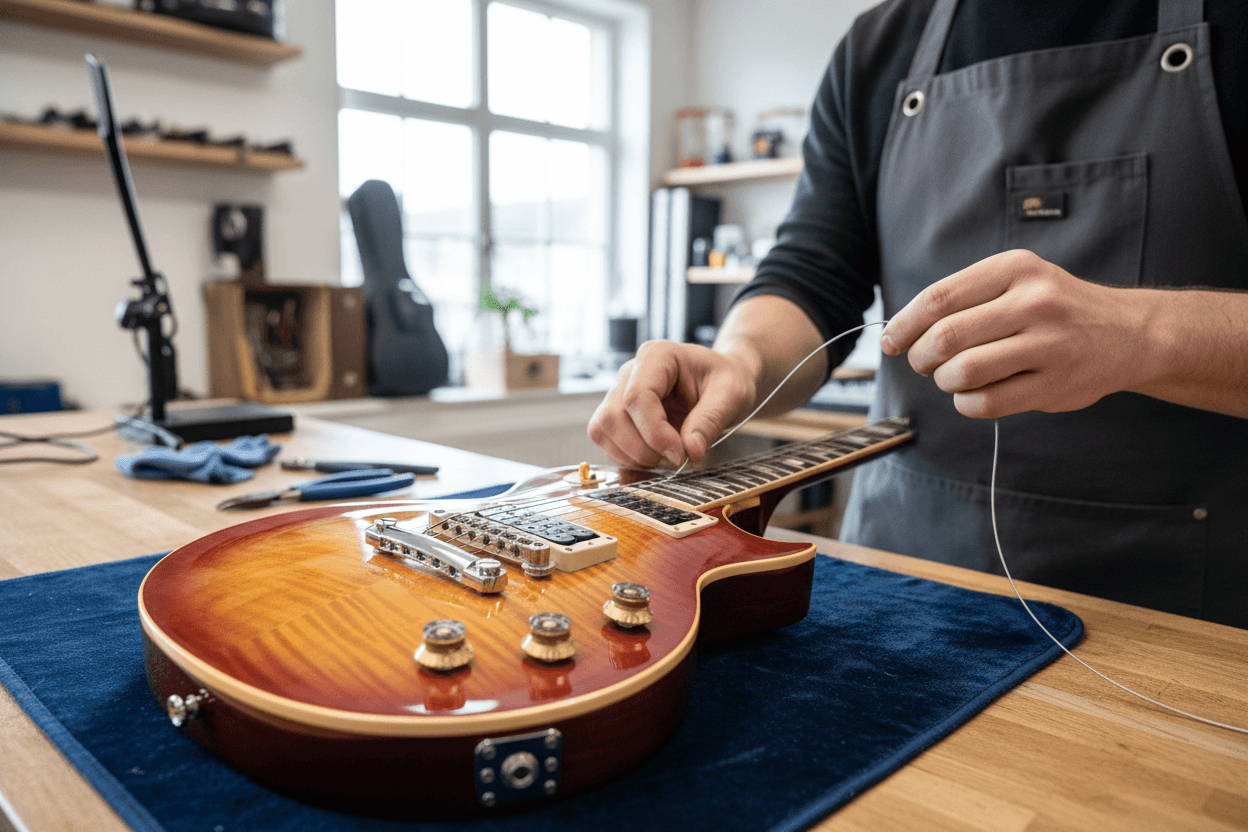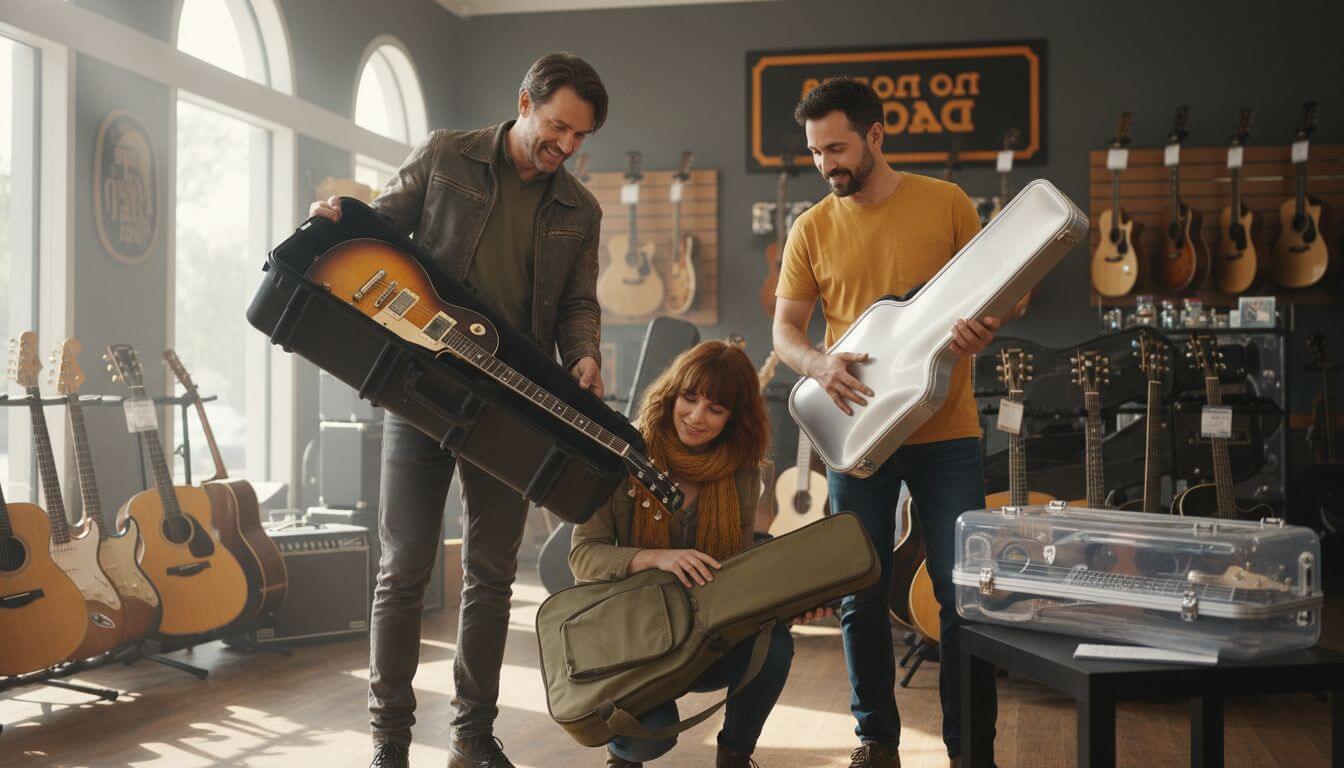Many guitar enthusiasts are surprised to learn that only a small percentage of old guitars truly qualify as vintage. The line between a dusty attic find and a highly prized collectible is sharper than most people realize. Understanding what makes a guitar vintage reveals a hidden world where craftsmanship, rarity, and storied histories shape both value and reputation. If you want to spot remarkable instruments and avoid common myths, knowing these distinctions will transform how you see every guitar you encounter.
Table of Contents
- Defining Vintage Guitar And Common Misconceptions
- Major Types Of Vintage Guitars Explained
- Key Characteristics And Value Factors
- Vintage Guitar Authentication And Provenance
- Comparing Vintage, Used, And Reissue Guitars
- Buying, Selling, And Preserving Vintage Guitars
Key Takeaways
| Point | Details |
|---|---|
| Definition of Vintage Guitar | Vintage guitars are crafted pieces of musical history from specific eras, particularly valued for their craftsmanship and unique characteristics. |
| Distinction from Used Instruments | Not all old guitars are valuable; true vintage guitars are recognized based on provenance, condition, and rarity. |
| Provenance and Authentication | Authentication of vintage guitars involves careful examination of manufacturing details and history to ensure genuine status. |
| Preservation Practices | Proper climate control and storage are essential for maintaining the integrity and value of vintage guitars. |
Defining Vintage Guitar and Common Misconceptions
A vintage guitar is not simply an old instrument, but a meticulously crafted piece of musical history that carries significant cultural and monetary value. These guitars, typically manufactured between the 1920s and 1970s, represent a golden era of instrument production where craftsmanship, materials, and design converged to create extraordinary musical tools.
Contrary to popular belief, not every aged guitar qualifies as vintage. Collectors and musicians distinguish true vintage guitars through specific characteristics. As seen with the Gibson J-45, a legendary model introduced in 1942, true vintage guitars demonstrate exceptional build quality, unique tonal characteristics, and historical significance. Key indicators include:
- Original hardware and components
- Limited production runs
- Handcrafted construction techniques
- Unique wood selections and finishes
- Provenance and documented history
One fascinating aspect of vintage guitars is their subtle imperfections. According to Yamaha, guitars develop “checking” - fine lacquer cracks resulting from wood expansion and contraction with temperature changes. These marks aren’t flaws but cherished signatures of an instrument’s journey, telling stories of performances, recording sessions, and musical adventures.
Understanding vintage guitars requires appreciating their nuanced value beyond mere age. While many assume any old guitar is valuable, serious collectors know that provenance, condition, rarity, and historical context determine true worth. Whether you’re a seasoned musician or a passionate collector, recognizing these subtle distinctions transforms how you perceive these remarkable musical artifacts.
For more insights into legendary guitar histories, explore our Rock n’ Roll Relics article that delves deeper into iconic instruments that shaped music history.
Major Types of Vintage Guitars Explained
Vintage guitars are not a monolithic category but a diverse landscape of extraordinary instruments representing different musical eras and styles. Acoustic vintage guitars and electric vintage guitars each tell unique stories through their design, construction, and historical significance.
In the acoustic realm, legendary models like the Gibson J-200 exemplify vintage craftsmanship. Introduced in 1937, this ‘Super Jumbo’ guitar features a distinctive large body and iconic ‘moustache’ bridge, representing the pinnacle of pre-war acoustic design. Vintage acoustic guitars typically fall into several subcategories:
- Dreadnought guitars
- Jumbo guitars
- Parlour guitars
- Archtop acoustic models
- Resonator guitars
Electric vintage guitars offer equally fascinating variations. The Fender Musicmaster, produced from 1956 to 1982, represents an important student model that showcases the evolution of electric guitar design. These vintage electric guitars can be categorised into:
- Solid body electric guitars
- Semi-hollow body guitars
- Full hollow body electric guitars
- Single pickup configurations
- Dual pickup models
Understanding these categories helps musicians and collectors appreciate the nuanced differences between vintage instruments. Each type represents a specific moment in musical instrument development, reflecting technological innovations, manufacturing techniques, and the artistic movements of its time.
For more comprehensive insights into guitar varieties, explore our Types of Electric Guitar: 7 Essential Varieties guide that provides deeper context on instrument classifications.
Key Characteristics and Value Factors
The value of a vintage guitar extends far beyond its age, encompassing a complex interplay of historical significance, craftsmanship, materials, and rarity. Serious collectors and musicians understand that not all old guitars are valuable, but those with exceptional provenance can command extraordinary prices.
Material selection plays a crucial role in determining a vintage guitar’s worth. Take the Gibson Advanced Jumbo, for instance. Produced between 1936 and 1938, this guitar’s value is significantly enhanced by its specific construction: rosewood back and sides, Adirondack spruce top, and an incredibly limited production of only 300 units. Such precise material choices and extreme rarity dramatically increase a vintage instrument’s collectible status.
Key characteristics that influence a vintage guitar’s value include:
- Original and unmodified components
- Pristine or well-preserved condition
- Documented provenance and ownership history
- Unique wood selections
- Limited production numbers
- Historical significance
- Manufacturer reputation
- Aesthetic preservation
Interestingly, different guitar types have unique value determinants. Flamenco guitars, characterized by their lighter construction and thinner tops, derive value from their specialized design and cultural significance. The use of specific materials like Spanish cypress or rosewood contributes to their distinctive sound and collectible nature.
Beyond physical attributes, a vintage guitar’s value is deeply connected to its narrative. Instruments associated with legendary musicians, used in iconic recordings, or representing pivotal moments in musical evolution command premium prices. Collectors aren’t just purchasing an instrument; they’re acquiring a piece of musical history.
For those interested in understanding guitar investments more comprehensively, our Are Guitars a Good Financial Investment? article offers deeper insights into the economic aspects of guitar collecting.
Vintage Guitar Authentication and Provenance
Vintage guitar authentication is a meticulous process that requires deep expertise, forensic-like investigation, and comprehensive knowledge of instrument manufacturing history. Collectors and musicians must navigate a complex landscape of historical details, subtle manufacturing nuances, and potential restoration impacts to determine an instrument’s genuine vintage status.
Take the Gibson J-200, for example. Historical models produced between 1937 and 1947 are particularly prized by collectors, with early rosewood versions commanding exceptional value due to their distinctive features and extreme rarity. Authentication involves examining multiple critical elements:
- Original manufacturing stamps and serial numbers
- Precise wood selection and grain patterns
- Hardware configuration and manufacturing techniques
- Consistency with period-specific design elements
- Verifiable documentation and ownership history
- Expert assessments from recognized vintage guitar authorities
Another fascinating example is the Gibson Hummingbird, introduced in 1960. Early versions featuring solid Sitka spruce tops and mahogany backs represent a specific moment in guitar manufacturing, making authentication a nuanced process of comparing historical specifications against the specific instrument being evaluated.
Successful authentication requires more than visual inspection. Serious collectors employ sophisticated techniques including spectographic wood analysis, electronic imaging, hardware metallurgy testing, and comprehensive historical research. Professional authenticators develop an almost intuitive understanding of how vintage guitars were constructed, allowing them to detect even the most subtle inconsistencies that might indicate reproduction or inappropriate restoration.

For musicians and collectors seeking deeper insights into guitar valuation, our guide to guitar investment offers comprehensive strategies for understanding the intricate world of vintage instrument authentication and investment.
Comparing Vintage, Used, and Reissue Guitars
Guitar collectors and musicians face a complex landscape when distinguishing between vintage, used, and reissue instruments. Each category represents a unique approach to musical heritage, performance, and value, with subtle yet significant differences that impact a musician’s playing experience and investment potential.
Reissue guitars represent a fascinating bridge between historical craftsmanship and modern manufacturing. Fender’s American Ultra Luxe Vintage series exemplifies this approach, combining classic aesthetics with contemporary performance features. These instruments offer musicians the best of both worlds:
- Authentic vintage design elements
- Modern manufacturing precision
- Enhanced playability
- Updated materials
- Improved structural integrity
- Contemporary performance capabilities
The Gibson J-45, in continuous production since 1942, demonstrates how legendary instruments evolve. Modern reissues retain the original’s core design while incorporating updated materials and construction techniques, allowing musicians to access historically significant instrument characteristics with improved reliability.
Critical differences between these guitar categories include:
- Vintage guitars: Original instruments from specific historical periods
- Used guitars: Pre-owned instruments of varying ages and conditions
- Reissue guitars: Modern reproductions capturing classic design elements
Musicians must carefully evaluate their priorities.
 Vintage guitars offer unparalleled historical authenticity but may require extensive maintenance. Used guitars provide more affordable options with established character. Reissue guitars deliver modern reliability with nostalgic aesthetics.
Vintage guitars offer unparalleled historical authenticity but may require extensive maintenance. Used guitars provide more affordable options with established character. Reissue guitars deliver modern reliability with nostalgic aesthetics.
For musicians navigating these complex purchasing decisions, our Second Hand vs New Guitars guide provides comprehensive insights into making informed instrument selections.
Buying, Selling, and Preserving Vintage Guitars
Vintage guitar investment requires a sophisticated approach that balances passion, technical knowledge, and strategic preservation. Musicians and collectors must navigate a complex landscape of authentication, market dynamics, and careful maintenance to protect these extraordinary musical instruments.
Yamaha provides crucial preservation advice, emphasizing the critical importance of maintaining constant humidity and reasonable temperature ranges. These conditions prevent ‘checking’—the delicate cracking in lacquer finishes that can dramatically reduce a vintage guitar’s value. Key preservation strategies include:
- Control ambient humidity (45-55% ideal range)
- Avoid extreme temperature fluctuations
- Use professional-grade guitar humidifiers
- Store in climate-controlled environments
- Invest in professional protective cases
- Conduct regular professional inspections
The Gibson Hummingbird exemplifies the nuanced world of vintage guitar collecting, with various models and limited editions highlighting the importance of understanding specific production years and features. When buying or selling, collectors must consider:
- Detailed provenance documentation
- Original manufacturer specifications
- Condition and originality of components
- Restoration history
- Market demand for specific models
- Potential future appreciation
Successful vintage guitar transactions require deep research, expert consultation, and a comprehensive understanding of market trends. Collectors should approach each instrument as a unique piece of musical history, recognizing that value extends far beyond monetary considerations.
For musicians navigating the intricate world of vintage guitar purchases, our 7 Risk-Minimizing Rules When Buying Used Guitars Online guide offers essential insights to protect your investment.
Discover Your Perfect Vintage Guitar Journey at MusicStreet
Navigating the world of vintage guitars can be overwhelming with so many details to consider—authenticity, condition, provenance and unique characteristics all play a vital role in finding an instrument that truly resonates with your musical passion. If you feel daunted by the complexities explained in the “What Is Vintage Guitar? Complete Guide for Musicians,” you are not alone. Many enthusiasts struggle to identify authentic vintage guitars and understand their true value or the best way to maintain their charm and sound.
At MusicStreet.co.uk, we specialise in helping musicians like you cut through the confusion with our carefully selected range of premium vintage, used and reissue guitars. Every instrument we offer is meticulously checked for originality and quality so you can trust the history and condition of your guitar. We also provide expert advice on preservation and investment, making sure your guitar is as rewarding a purchase as its story deserves.
Explore our expert guides and resources to deepen your understanding or visit us in Huntingdon for personal consultations and professional setups that keep your instrument in peak condition.

Ready to find your authentic vintage guitar or a trustworthy reissue that captures the spirit of the original? Start your musical journey today with confidence and expert support by visiting MusicStreet.co.uk to browse our handpicked collection and connect with a community that shares your passion.
Frequently Asked Questions
What defines a vintage guitar?
A vintage guitar is typically defined as an instrument that was made between the 1920s and 1970s, characterized by exceptional craftsmanship, unique tonal qualities, and historical significance.
How do I determine the value of a vintage guitar?
The value of a vintage guitar is influenced by factors such as original and unmodified components, condition, documented provenance, unique materials, and historical significance.
What are the main types of vintage guitars?
The main types of vintage guitars include acoustic guitars (like dreadnoughts, jumbos, and parlour guitars) and electric guitars (such as solid body, semi-hollow, and full hollow body guitars), each reflecting distinct design and musical eras.
How can I authenticate a vintage guitar?
Authenticating a vintage guitar requires examining original manufacturing stamps, wood selection, hardware configuration, and any available documentation. Expert assessments from recognized authorities can further confirm the instrument’s age and authenticity.




Share:
PRS Guitars Explained: Quality, Types, and Features
Why Boutique Guitars: Everything You Need to Know